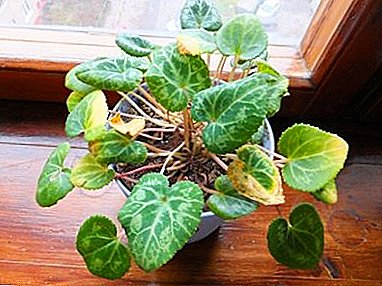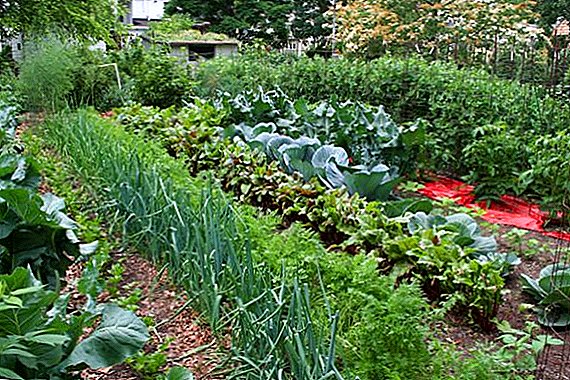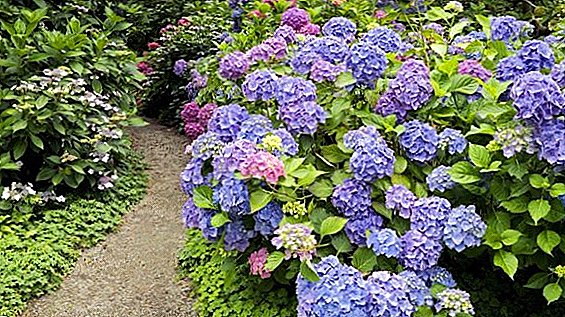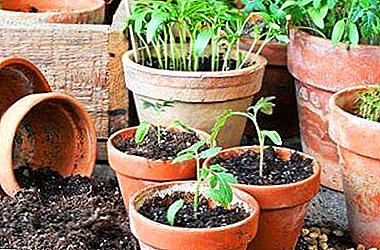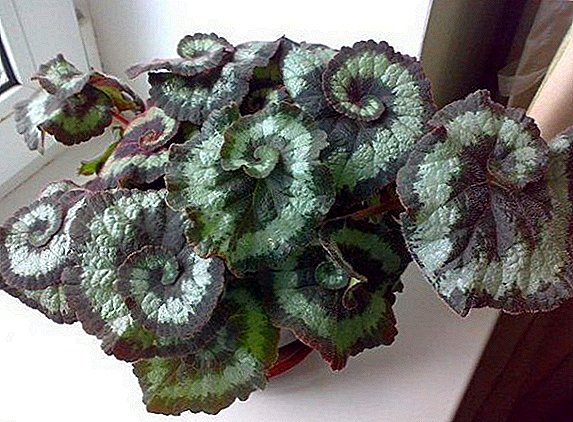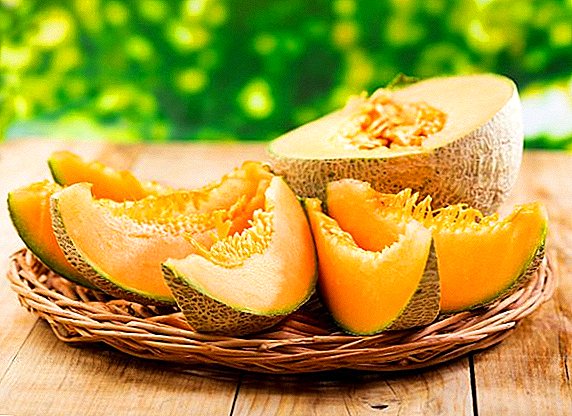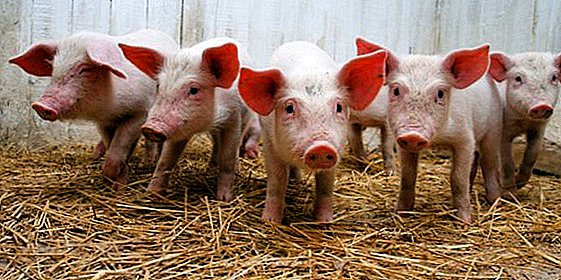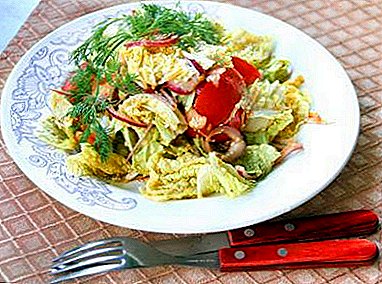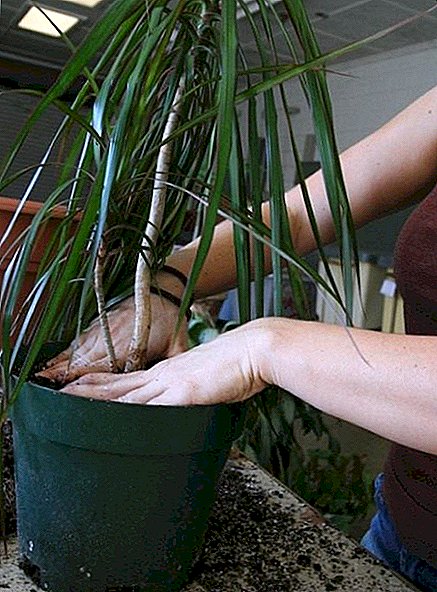
Transplantation is a serious stress for any indoor flower, so many flower growers are not without reason to be wary of this procedure.
But the problem is that in the ground, the amount of which is limited by the volume of the pot, the root system of the plant cannot exist for long, and therefore it is impossible to do without periodic transplants. Find out when and how to transplant dracaena to cause her minimal anxiety.
When you need to transplant dracaena
There are three main reasons for the need to transplant houseplants:
- depletion of the soil due to the lack of the possibility of its natural renewal;
- insufficient volume of the pot, where the developing root system of the flower becomes crowded;
- development of root rot and other dangerous diseases that require immediate and complete replacement of contaminated soil.
However, if the first two of the above reasons determine the planned transplantation, the third requires an immediate response, regardless of the season, the vegetative phase of flower development and other related factors.

In addition to disease, there is another case where the flower must be transplanted and as soon as possible into a new soil mixture. Many novice growers do not know about this rule, and therefore they face the fact that a newly acquired plant at first seems to be well acclimatized in a new place, but then it begins to wither and stops developing.
The fact is that in the flower shops plants are sold in a special transport substrate. It contains a high content of nutrients and allows you to better maintain the decorative qualities of the flower in the short term, but for permanent finding absolutely not suitable. It is for this reason that the dracenum should be transplanted after purchase, and it is better to do it right away so that the adaptation process of the false palm will take place in a new pot.
Read also how to choose drazenas for the house.
As for planned transplants, it is best to conduct them in late winter or early spring. During this period, the duration of the day begins to increase and the flower leaves the state of rest, but has not yet entered the active vegetation phase, which means that it will be easier for him to survive the stress from the inevitable damage to the root system than in summer or autumn.
The answer to the question of how often it is necessary to carry out a similar procedure depends directly on the age of the plant. In young plants, the root system develops very intensively, so the capacity for them must be increased annually. It is enough to transplant the adult dragon flower no more than once every 2-3 years, and in the intervals between transplants it is necessary to refresh the top layer of soil in the pot every year.
Preparing for a transplant
Dracaena transplant - the procedure is not so complicated. However, in order to make the process as painful as possible for a flower, it is necessary to take a responsible approach to the preparatory work.

Pot selection
From the pot in which the plant will be transplanted, the time it takes for the flower to adapt depends largely. As the desire to save, getting the cheapest tank, and decorative qualities of the flowerpot, allowing you to fit into the interior of the room as much as possible, should not be decisive in selecting the appropriate tank.
Important! The pot should be selected based on the needs of a particular plant. Personal tastes of the owner - the criterion is essential, but not paramount.
The existing opinion that the capacity of a natural material (clay, ceramics) has significant advantages over plastic, in fact, greatly exaggerated. Both of these materials have their advantages and disadvantages. When making a choice, the following considerations should be taken into account:
| Type of material | Virtues | disadvantages |
| Plastic |
|
|
| Clay |
|
|
Thus, in a number of cases, a plastic pot is not only not inferior in its characteristics to ceramic, but is even more preferable. In general, it can be said that for growing dracaenes, the material from which the pot is made does not have a decisive significance.
The main requirements that must necessarily meet the pot for dracaena:
- Having a good drainage system in the form of holes at the bottom of the tank through which excess moisture will drain.
- The form. The dracaena root system can be described as superficial, but still, for the stability of a false palm, a capacity rather high than a broad one is needed.
- Dimensions. You should never transplant dracaena in too large a container: this will slow down and complicate the process of plant adaptation, and also increase the likelihood of water stagnation in the roots. The pot should be selected in such a way that its diameter and height were only 2-3 cm larger than the previous one. If we consider that each root process increases its length by about 1-2 cm over the year, the new size of the pot will ensure normal development of the plant during the next 2-3 years to the next transplant.
Did you know? On the island of Socotra in the Indian Ocean a very rare cinnabar-red dracaena (Dracaena cinnabari) grows, which the aborigines call the Dragon Tree. The sap of the plant is bright red and has strong antiseptic properties; therefore, local shepherds, fishermen and farmers associate it with dragon's blood.
Soil preparation
Dracaena is not too demanding on the composition of the soil, but it is best suited to the substrate, which has the following characteristics:
- ease;
- friability;
- high permeability;
- neutral, close to neutral or weakly acid reaction (pH level within 6.0-6.5).
Land for transplanting plants can be prepared independently, using, for example, one of the following "recipes":
- Turf ground, river sand, humus in equal parts.
- Sod or leaf soil, humus, peat in equal parts with a small addition of charcoal.
- Turf ground, leaf earth, humus, peat, river sand in equal parts.
- Garden land and river sand in a 2: 1 ratio.
- Turf, leaf soil, compost and peat in a ratio of 2: 2: 1: 1.

Whatever the prepared substrate, it must necessarily include a drainage component - sand, vermiculite, coconut fiber, broken nutshells, etc. But there should not be too much peat in the soil, because this material holds water for a very long time, which is not very suitable for dracaena.
The soil mix acquired in a specialty store can be used to transplant plants immediately after purchase. However, if the earth was prepared on its own, it must first be pickled (disinfected).
Important! When purchasing a ready-made substrate in a flower shop, you should focus on soil mixtures for palm trees, ficuses, or yucca, which have similar soil composition requirements.
This can be done in several ways, for example:
- put in a container with low sides and pour plenty of boiling water or a weak solution of potassium permanganate;
- spread out on a baking sheet and send to the oven, heated to + 70 ° С for 2-3 hours;
- soak in the freezer (or take out to the balcony if the air temperature is no higher than -10 ° C) for 12 hours, then let it warm up at room temperature for the same time and place again in frost.
Dragon processing
If we are talking about a planned transplant, it is not necessary to conduct any preparatory activities with the tree itself. The only recommendation is not to water the plant for several days before the procedure, so that it is easier for the earthen ball to be removed from the pot without damaging the root system.

However, in cases where the purpose of the transplant is to completely replace the land (for example, after the purchase) and to treat possible infections that hit the flower, the technology for preparing the preparation for such manipulation changes somewhat, since in such a situation it is important not just to move the flower to a new capacity, but and make sure that its root system is healthy and viable. In order for the roots to be examined, the soil in the pot must be sufficiently moist before transplanting.
Carefully pulling an earthen ball out of the pot, slightly shake off the soil from the roots and carefully study their condition. A good sign is the absence of thickenings and deformations on the root processes, their smooth structure and bright yellow color. All damaged, dried or rotting fragments must be removed. If their number seems significant, the plant should be disinfected by placing its root system in a saturated solution of potassium permanganate for 30 minutes.
We recommend to read how to grow indoor dracenum.
After the roots have been washed, the dragon seed is re-examined very carefully, this time the condition of the trunk is to be studied. Often, fungal infections are manifested by the presence of rotten patches on the stem. It is important to remove these foci of disease to healthy tissue, and sprinkle the places where pruning is done with pounded activated carbon, wood ash, or another disinfectant, otherwise the disease will progress and the plant will eventually die.
If the affected areas cover the entire lower part of the trunk, it is more correct to throw away the flower so that the infection does not spread to other indoor plants, and even with healthy cuttings in such a situation it is safer to neglect without trying to root them, as the probability that they will be infected is very is high.
How to transplant dracaena at home: step by step instructions
When all the preparatory work is finished, you can proceed directly to the transplant itself.

For this, in addition to the pot, soil mix and drainage material, you will additionally need:
- rubber gloves;
- soap solution for processing the pot;
- alcohol or hydrogen peroxide and cotton pads for disinfecting containers;
- spoon for work with the earth;
- tank filled with settled water with a spray.
The step by step procedure is as follows:
- If the dragon flower is supposed to be transplanted into a pot that has already been in use, the container should be completely freed from the ground, washed with soap and thoroughly wiped with a cotton pad dipped in alcohol or hydrogen peroxide.
- Place a clean pot in the pan, pour drainage material to the bottom so that its layer takes about 20-25% of the height of the pot.
- Pour a small, up to 1 cm layer of earth over the drainage. In the case of transshipment (transplanting a plant with an earthen clod), it should be flat; for a classic transplant, a small elevation must be built in the center, on the sides of which it is convenient to place the roots.
- If the root system of the dracaena was bare, it is necessary to carefully spray it with water from a spray bottle.
- Set the plant in the center of the pot, straightening the roots around the perimeter.
- Carefully fill the remaining space with the ground so that the root neck of the dracaena is flush with the surface (with excessive depth, the development of the plant slows down a lot).
- Thoroughly tamp the surface layer of soil to prevent the presence of cavities around the roots, but at the same time to prevent their mechanical damage and not to make the earth clot too dense.
- Liberally pour the soil a little warm soft water (it is better to use rain or thawed at this stage) to improve the contact between the soil and the roots.
- After watering, add some more loose earth to the surface or, if desired, a layer of expanded clay or decorative stones to preserve moisture in the soil.
Video: drafts transfer
Further care
In the first two weeks after transplantation, usually an unpretentious dracaena needs an especially gentle maintenance regime.
During this period, the plant can not:
- move from place to place;
- touch with hands or other objects;
- expose to drafts;
- overheat or overcool (at optimum temperature conditions + 18 ... + 25 ° С, which is required by the dracaena, after transplanting, the lower and upper bars of the specified range must be shifted by 2-3 degrees to each other);
- re-humidify and dry out (watering requires abundant, but dosed, it is also important to constantly spray warm above-ground part of the flower with warm water);
- leave under the influence of too bright sunny color (an ideal place for a pot - windows facing the east);
- feed (fertilization can burn the roots of the plant that did not have time to harden).
Did you know? An old legend connected with the dragon plant says that on one of the Indian islands there once lived an evil dragon, whose favorite delicacy was the blood of elephants. Wanting to save their kinsmen, one of their elephants was able to kill the monster, but he himself died in an unequal struggle, and when the blood of a predator and its victims mixed and sprinkled the earth, palm-like plants called dracenes grew from this place.
After the first, the most difficult, period of adaptation has come to an end, the dracaenum should be fed with mineral fertilizers containing potassium and phosphorus, and gradually transferred to the usual mode of maintenance.
Possible errors during transplantation
Observing all the above recommendations, even a novice gardener can expect that the transplant of dracaenas will not lead to the loss of a plant and will have a favorable effect on its further growth.

But for this you need to avoid, first of all, the most characteristic mistakes:
- Non-compliance with the recommended regularity of transplants: once a year for young and every 2-3 years for adult plants.
- Incorrectly chosen time for the procedure: the planned transfer to a larger pot should be carried out at the end of winter or at the beginning of spring, but not at all in the summer and not in the autumn.
- Too big pot: the tank must be selected in such a way that the root system has the ability to quickly gain a foothold. As a rule, for this, the volume of the pot should be only 2-3 cm larger than the earthen room.
- Unsuitable ground: heavy and loamy soil, too acidic or alkaline soil, and garden soil oversaturated with minerals and organic matter (such soil can be used as a base, but additional components must be added to it) are not suitable for dracenum.
- Ignoring the requirement to carry out soil disinfection before placing it in the pot, as well as the tank itself.
- The absence of drainage holes in the pot and a thick drainage layer placed on its bottom under the soil mixture.
- Exposure and, as a result, damage to the roots of a plant before transplanting without special need (the safest way to move a plant to a new pot is transshipment, the roots should be exposed only in exceptional cases when the plant is in the wrong land for it, infected with diseases or pests) .
- Transplanting a diseased plant without first removing the damaged roots.
- Excessive penetration of the false palm into the soil.
- Excessive tamping of the earth or, on the contrary, leaving voids between the roots.
- Violation of the regime of follow-up care for transplanted dragonza, including the premature introduction of dressings.
Unlike some other ornamental houseplants, dracaena tolerates transplant quite easily. If you carry out the procedure regularly and do not allow for the most blunders, the false palm tree recovers fairly quickly and resumes its growth with a new force.


